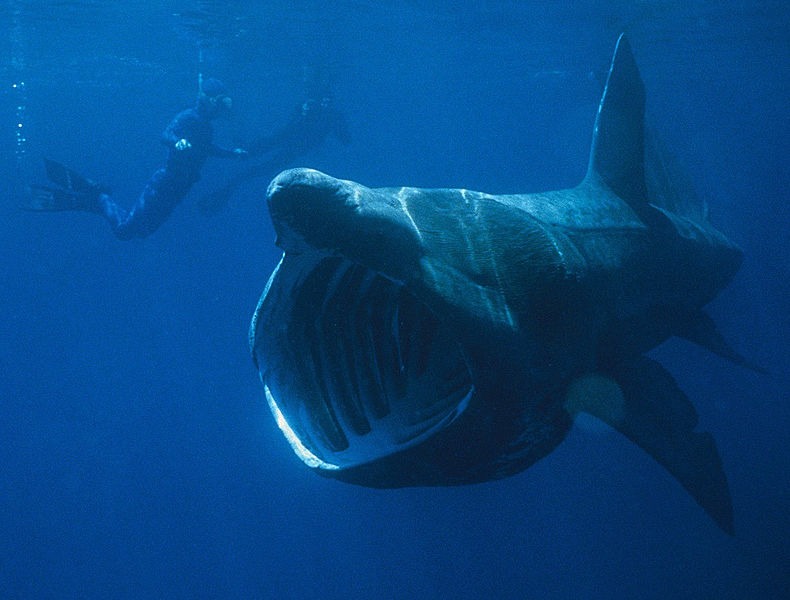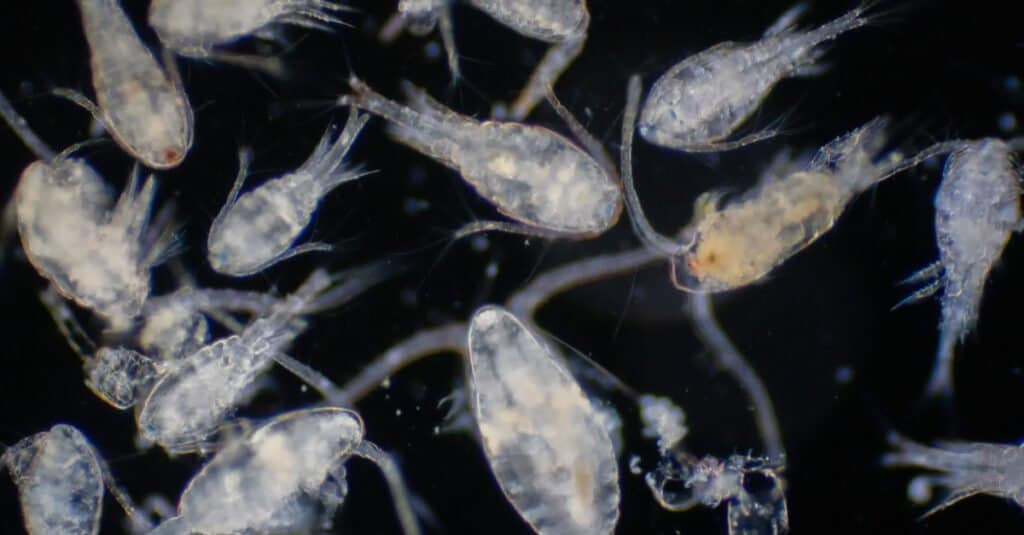
Basking Sharks are one of the ocean’s most mysterious marine life. They are the world’s second-largest fish right after the whale shark. Despite being related to the great white and having a predatory look, they are a gentle mackerel shark that survives off planktonic life.
They are quiet harmless and non-aggressive towards humans, however, given the fact that they are wild marine life and no one knows what they can do if they feel threatened, it is better to stay away from them. These sharks are often put in danger by ships or fishing nets. In some parts of the world they are seen as endangered species as well. The basking sharks are also ovoviviparous, which means that the embryo matures inside the eggs while the eggs are still inside the mothers body, and they give birth to babies that are 5 – 6, ft in length. Let’s take a look at what basking sharks eat and the unique way they feed.
How Does The Basking Shark Hunt?

Basking sharks open their mouth wide and feed!
©AVETPHOTOS/Shutterstock.com
Basking sharks are one of three species of sharks that are filter feeders. Unlike the other two species of filter-feeding sharks, the basking shark cannot suck water through its mouth and must passively feed. They swim through the water opening their large 3 foot (0.9 meters) mouth to collect plankton in long gill rakers, closing it occasionally to swallow and filter the plankton.
Basking sharks are migratory and will feed while traveling long distances. They are often seen near the surface of the water slowly moving at around 2.3 mph (4 kph). While it may look like they are basking in the sun, they are feeding off dense pockets of plankton near the water’s surface. Their gaping mouths filter water through their gills and the small plankton gets captured by the gill rakers, which are long and comb-like.
Basking sharks will feed in water with dense plankton pockets and will form large groups of up to 100. While their largemouth looks intimidating they will only eat small plankton and will go out of their way to avoid large objects.
What Do Basking Sharks Eat?

Basking Shark with mouth open
©Chris Gotschalk / Public Domain, from Wikimedia Commons, the free media repository – Original / License
Plankton is the main source of food for the basking shark but what exactly is it? Plankton is classified as a marine drifter and is an organism unable to swim, carried by the tide. There are two main types of plankton; phytoplankton, and zooplankton. The basking shark’s preferred food is zooplankton, specifically copepods.
Copepods are small crustaceans that are microscopic. Below you can see a zoomed in picture of what copepods look like under a microscope, enjoy how many of these basking sharks need to eat to consume their regular diet every day!

A microscope’s view of copepods
©Choksawatdikorn/Shutterstock.com
Basking sharks seek out copepods but other zooplankton may also be consumed like:
Annually in the winter basking sharks shed their gill rakers. Hibernation or a change in diet are some theories to what happens until they regrow them in spring.
How Much Do Basking Sharks Eat?

Filtering out hundreds of pounds of microscopic plankton per day!
©Martin Prochazkacz/Shutterstock.com
An adult can reach up to 30 feet in length and over 10,000 pounds in weight. Being ginormous, basking sharks need to eat a large amount of plankton to survive. Over 2,000 tons of water are filtered per hour by their gills. It is difficult to determine the actual amount of food that they eat in a single day, since plankton is so small they must eat millions each day which can be hundreds of pounds in weight alone.
Next Up…
- This 40 Foot Marine Predator Once Feasted on Sharks: Sharks are the most dangerous predator in the ocean, however, there was once a marine creature that feasted on sharks. Find out more here.
- 10 Incredible Dolphin Facts: No one in the world is oblivious to the charm and intelligence of these marine creatures. Learn more about dolphins and some amazing facts bout them.
- Blue Whale Size Comparison: Just How Big is the Biggest Animal in the World?: When it comes size, nothing can compare to that of a blue whale. Let find out how big they can really get.
The photo featured at the top of this post is © Martin Prochazkacz/Shutterstock.com
Thank you for reading! Have some feedback for us? Contact the AZ Animals editorial team.







